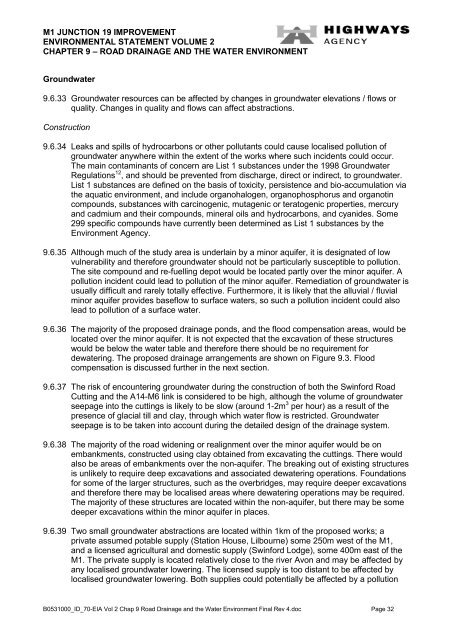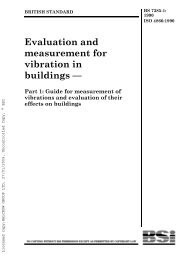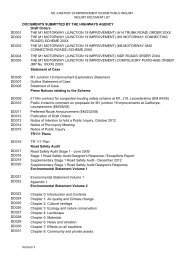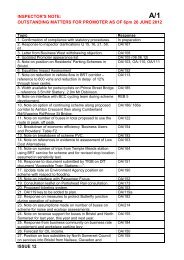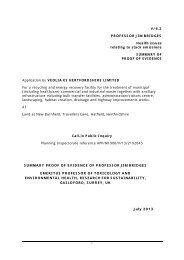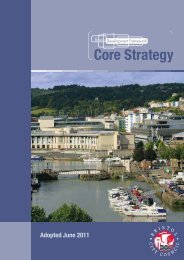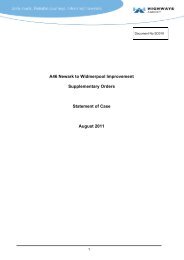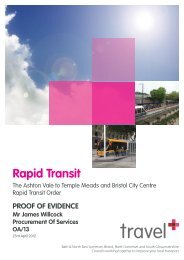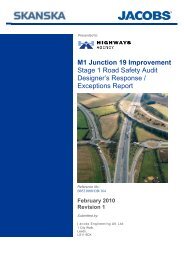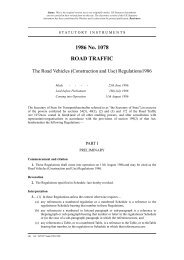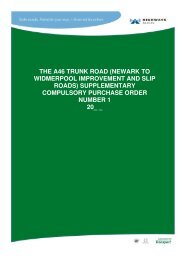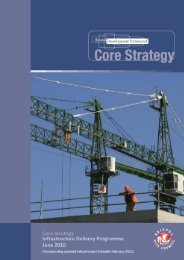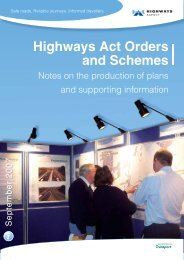Chapter 9: Road drainage and the water environment
Chapter 9: Road drainage and the water environment
Chapter 9: Road drainage and the water environment
Create successful ePaper yourself
Turn your PDF publications into a flip-book with our unique Google optimized e-Paper software.
M1 JUNCTION 19 IMPROVEMENT<br />
ENVIRONMENTAL STATEMENT VOLUME 2<br />
CHAPTER 9 – ROAD DRAINAGE AND THE WATER ENVIRONMENT<br />
Ground<strong>water</strong><br />
9.6.33 Ground<strong>water</strong> resources can be affected by changes in ground<strong>water</strong> elevations / flows or<br />
quality. Changes in quality <strong>and</strong> flows can affect abstractions.<br />
Construction<br />
9.6.34 Leaks <strong>and</strong> spills of hydrocarbons or o<strong>the</strong>r pollutants could cause localised pollution of<br />
ground<strong>water</strong> anywhere within <strong>the</strong> extent of <strong>the</strong> works where such incidents could occur.<br />
The main contaminants of concern are List 1 substances under <strong>the</strong> 1998 Ground<strong>water</strong><br />
Regulations 12 , <strong>and</strong> should be prevented from discharge, direct or indirect, to ground<strong>water</strong>.<br />
List 1 substances are defined on <strong>the</strong> basis of toxicity, persistence <strong>and</strong> bio-accumulation via<br />
<strong>the</strong> aquatic <strong>environment</strong>, <strong>and</strong> include organohalogen, organophosphorus <strong>and</strong> organotin<br />
compounds, substances with carcinogenic, mutagenic or teratogenic properties, mercury<br />
<strong>and</strong> cadmium <strong>and</strong> <strong>the</strong>ir compounds, mineral oils <strong>and</strong> hydrocarbons, <strong>and</strong> cyanides. Some<br />
299 specific compounds have currently been determined as List 1 substances by <strong>the</strong><br />
Environment Agency.<br />
9.6.35 Although much of <strong>the</strong> study area is underlain by a minor aquifer, it is designated of low<br />
vulnerability <strong>and</strong> <strong>the</strong>refore ground<strong>water</strong> should not be particularly susceptible to pollution.<br />
The site compound <strong>and</strong> re-fuelling depot would be located partly over <strong>the</strong> minor aquifer. A<br />
pollution incident could lead to pollution of <strong>the</strong> minor aquifer. Remediation of ground<strong>water</strong> is<br />
usually difficult <strong>and</strong> rarely totally effective. Fur<strong>the</strong>rmore, it is likely that <strong>the</strong> alluvial / fluvial<br />
minor aquifer provides baseflow to surface <strong>water</strong>s, so such a pollution incident could also<br />
lead to pollution of a surface <strong>water</strong>.<br />
9.6.36 The majority of <strong>the</strong> proposed <strong>drainage</strong> ponds, <strong>and</strong> <strong>the</strong> flood compensation areas, would be<br />
located over <strong>the</strong> minor aquifer. It is not expected that <strong>the</strong> excavation of <strong>the</strong>se structures<br />
would be below <strong>the</strong> <strong>water</strong> table <strong>and</strong> <strong>the</strong>refore <strong>the</strong>re should be no requirement for<br />
de<strong>water</strong>ing. The proposed <strong>drainage</strong> arrangements are shown on Figure 9.3. Flood<br />
compensation is discussed fur<strong>the</strong>r in <strong>the</strong> next section.<br />
9.6.37 The risk of encountering ground<strong>water</strong> during <strong>the</strong> construction of both <strong>the</strong> Swinford <strong>Road</strong><br />
Cutting <strong>and</strong> <strong>the</strong> A14-M6 link is considered to be high, although <strong>the</strong> volume of ground<strong>water</strong><br />
seepage into <strong>the</strong> cuttings is likely to be slow (around 1-2m 3 per hour) as a result of <strong>the</strong><br />
presence of glacial till <strong>and</strong> clay, through which <strong>water</strong> flow is restricted. Ground<strong>water</strong><br />
seepage is to be taken into account during <strong>the</strong> detailed design of <strong>the</strong> <strong>drainage</strong> system.<br />
9.6.38 The majority of <strong>the</strong> road widening or realignment over <strong>the</strong> minor aquifer would be on<br />
embankments, constructed using clay obtained from excavating <strong>the</strong> cuttings. There would<br />
also be areas of embankments over <strong>the</strong> non-aquifer. The breaking out of existing structures<br />
is unlikely to require deep excavations <strong>and</strong> associated de<strong>water</strong>ing operations. Foundations<br />
for some of <strong>the</strong> larger structures, such as <strong>the</strong> overbridges, may require deeper excavations<br />
<strong>and</strong> <strong>the</strong>refore <strong>the</strong>re may be localised areas where de<strong>water</strong>ing operations may be required.<br />
The majority of <strong>the</strong>se structures are located within <strong>the</strong> non-aquifer, but <strong>the</strong>re may be some<br />
deeper excavations within <strong>the</strong> minor aquifer in places.<br />
9.6.39 Two small ground<strong>water</strong> abstractions are located within 1km of <strong>the</strong> proposed works; a<br />
private assumed potable supply (Station House, Lilbourne) some 250m west of <strong>the</strong> M1,<br />
<strong>and</strong> a licensed agricultural <strong>and</strong> domestic supply (Swinford Lodge), some 400m east of <strong>the</strong><br />
M1. The private supply is located relatively close to <strong>the</strong> river Avon <strong>and</strong> may be affected by<br />
any localised ground<strong>water</strong> lowering. The licensed supply is too distant to be affected by<br />
localised ground<strong>water</strong> lowering. Both supplies could potentially be affected by a pollution<br />
B0531000_ID_70-EIA Vol 2 Chap 9 <strong>Road</strong> Drainage <strong>and</strong> <strong>the</strong> Water Environment Final Rev 4.doc Page 32


